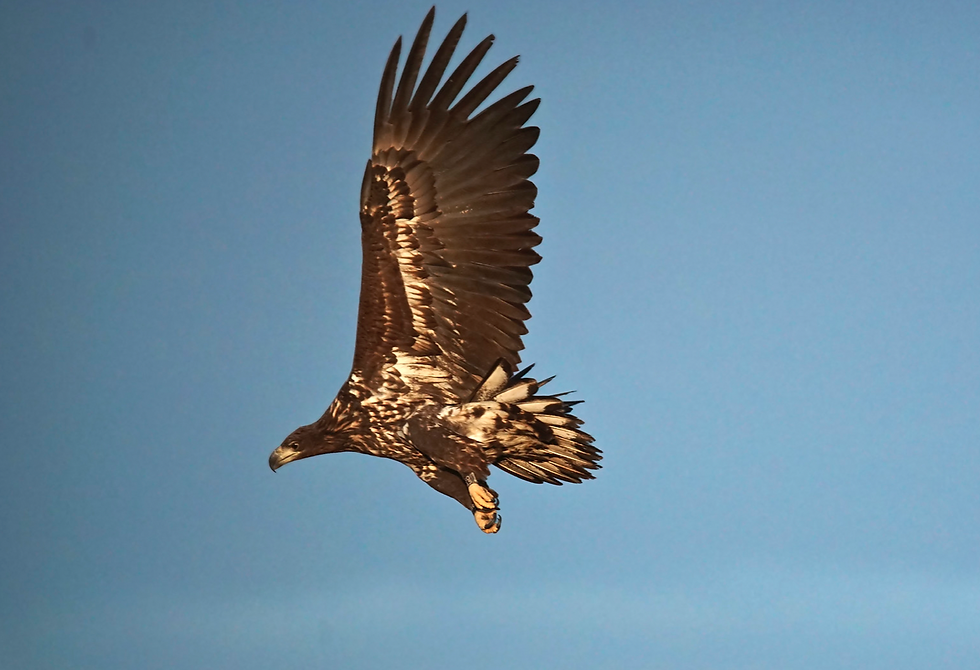
Stock image of white tailed eagle: Thomas Landgren
For anyone who loves birds, the Avian Influenza outbreaks that we have seen this year are absolutely devastating. Whether a hobby-ist birdwatcher, a smallholder with a small mixed flock, a gamekeeper, an RSPB worker or simply a shoreside dog walker, the stories and sights are both saddening and worrying. The sight of hundreds of dead birds washed up on a Cornish beach; the news of 2.8 million poultry and captive birds having been culled, and the reports of rare species such as curlew and sea eagles succumbing to the disease are tragic.
Biosecurity is of the utmost importance at this time. That applies to anyone transporting, working with or handling birds, whether or not they are aware of an AI outbreak in their area.
The question, then, surrounds the fact that the RSPB are continuing to access rare birds and ring them, despite Avian Influenza being widespread throughout the country. The RSPB Scotland's Mull Officer, Dave Sexton, has written an upsetting blog about the situation regarding white tailed eagle nests on the Scottish island. So far this year, writes Dave of the island’s sea eagle chicks, “at least four have either died in the nest or soon after fledging. This is on top of losses from bad weather and tree collapses earlier in the year.”
Monitoring sea eagle nests from afar, Dave writes of how he grew increasingly worried about two nests where there had once been healthy young chicks, but no now sign of movement. Through a telescope he could see feathers; but the chicks didn’t appear to be moving at all. When NatureScot managed to send climbers to investigate – all fully kitted out “with full PPE, face masks and ventilators” – they sadly confirmed what had been suspected: the chicks were dead. At least one of these has tested positive for HPAI – Highly Pathogenic Avian Influenza.
Sea eagles are scavengers, and the RSPB officer suggests that the reason the chicks have died is because the parent birds have unwittingly been feeding their young with scavenged and diseased dead birds found on the shore. Seabirds have been affected in huge numbers by the avian influenza outbreak – so this could well be the case. But if the chicks are succumbing to avian flu through this means then surely the parents would also be likely to contract the disease through infected food? It appears to only be chicks who have died from avian flu; in both cases the parent birds are still alive and well.
Others are suggesting that perhaps the sea eagles didn’t contract the disease from eating dead birds at all. Before the chicks died, they had been ringed by RSPB ringers. Some people suspect that when the pre-fledged chicks were lowered from the tree in holdalls to be measured/weight, checked over and then ringed, this is the point at which they have contracted avian flu. “I suspect that the holdall bags or equipment used are contaminated as they move from nest to nest” wrote one commenter. “Humans can get and carry the virus as well.”

So which is the truth? It is most likely we will never know, but there are a number of strange aspects to this story. How is it that photographs have been published online of a chick which was later found dead? Did the person taking those photographs have the same level of bio secure PPE as the NatureScot officers sent to take swabs after its death? Did the ringers disinfect all of their kit between each nest, change their clothes, their footwear, their vehicle?
Of course it’s important to collect data on birds, and particularly endangered species or ones which we know little about. But perhaps, given the prevalence of avian flu in wild birds at the moment, it’s time to stop any human interference. People may have the best intentions at heart; but if there is any risk at all that carrying out procedures such as ringing is spreading avian flu, surely it’s time to put a stop to them, until the outbreak is somewhat controlled.
